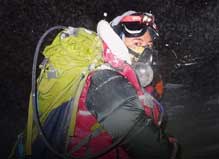Caring for Waterproof fabrics
Our waterproof HS3 fabric is proofed in two ways. Firstly, there is a waterproof, breathable laminate sandwiched between the outer ripstop nylon and the inner jersey fabric. This provides a permanent waterproof layer. Secondly, a DWR (durable water repellent) is applied to the outer surface of the ripstop nylon. This fine spray-on treatment protects the outer nylon layer and causes water droplets to “bead” and run off the garment. This in turn prevents the outer layer becoming soaked or “wetting out” maintaining breathability and preventing rapid heat loss.
To maintain the original DWR performance of HS3 fabric, a garment needs regular treatment with a technical performance wash and the application of a heat-activated waterproofing solution. As soon as the outer surface stops beading, it’s time to treat your garment. A waterproof item that has not had this treatment from early in its life is unlikely to recover to its full performance.
Various treatments are available, some chemical-based and some water-based. Those made by Grangers and Nikwax are most familiar and are widely available in the outdoor shops. Details of how to wash, treat, and heat activate their treatments are provided by these companies.
Andy Kirkpatrick and Chris Townsend have written useful background articles on the general performance of waterproofs.
In a similar way, the waterproofing and breathability of our 2-layer waterproof fabrics, HS2 and Dri-LX,* can be maintained by regularly applying a DWR using products available from the likes of Grangers and Nikwax.
* Used to create a fully-taped waterproof outer shell on our sleeping bags and garments.




















